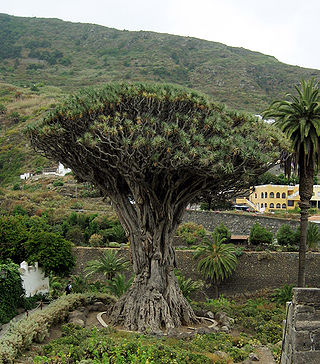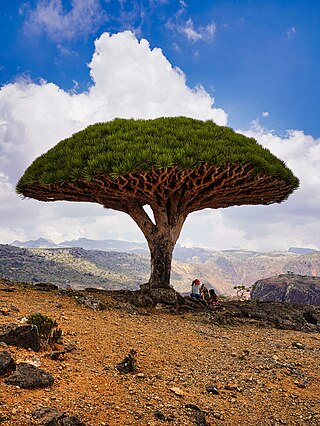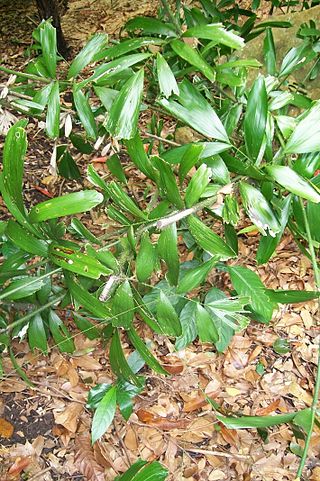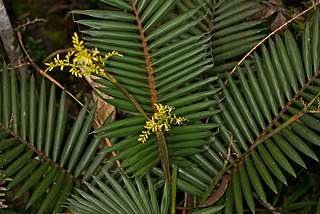
Rattan, also spelled ratan, is the name for roughly 600 species of Old World climbing palms belonging to subfamily Calamoideae. The greatest diversity of rattan palm species and genera are in the closed-canopy old-growth tropical forests of Southeast Asia, though they can also be found in other parts of tropical Asia and Africa. Most rattan palms are ecologically considered lianas due to their climbing habits, unlike other palm species. A few species also have tree-like or shrub-like habits.

Dracaena is a genus of about 200 species of trees and succulent shrubs. The formerly accepted genera Pleomele and Sansevieria are now included in Dracaena. In the APG IV classification system, it is placed in the family Asparagaceae, subfamily Nolinoideae. It has also formerly been separated into the family Dracaenaceae or placed in the Agavaceae.

Dragon's blood is a bright red resin which is obtained from different species of a number of distinct plant genera: Calamus spp. also including Calamus rotang, Croton, Dracaena and Pterocarpus. The red resin has been in continuous use since ancient times as varnish, medicine, incense, pigment, and dye.

Dracaena draco, the Canary Islands dragon tree or drago, is a subtropical tree in the genus Dracaena, native to the Canary Islands, Cape Verde, Madeira, western Morocco, and possibly introduced into the Azores.

Daemonorops was a genus of rattan palms in the family Arecaceae. Its species are now included within the genus Calamus. Species now placed in Daemonorops are dioecious, with male and female flowers on separate individuals. They are found primarily in the tropics and subtropics of southeastern Asia with a few species extending into southern China and the Himalayas.

Ceratolobus was a dioecious genus of flowering plants in the palm family found in Southeast Asia, commonly called rotan. Its species are now included within the genus Calamus. They were only differentiated from Calamus and close relatives like Korthalsia by leaf sheath appendages or inflorescence variations. The Greek genus name combines "horn" and "capsule".
Plectocomiopsis is a dioecious genus of flowering plant in the palm family found in Indochina, Malaysia, Borneo and Sumatra. Hapaxanthic and armed with spines, they are a climbing rattan, closely related to the Myrialepis palms. The name is Greek for "similar to Plectocomia", another close relative.

Calamus rotang, also known as common rattan, is a plant species native to India, Sri Lanka and Myanmar (Burma). It is one of the scandent (climbing) rattan palms used to make Malacca cane furniture, baskets, walking-sticks, umbrellas, tables and general wickerwork, and is found in Southwest Asia. The basal section of the plant grows vertically for 10 metres or so, after which the slender, tough stem of a few centimetres in diameter, grows horizontally for 200 metres or more. It is extremely flexible and uniform in thickness, and frequently has sheaths and petioles armed with backward-facing spines which enable it to scramble over other plants. It has pinnate, alternate leaves, 60–80 cm long, armed with two rows of spines on the upper face.

Dracaena cinnabari, the Socotra dragon tree or dragon blood tree, is a dragon tree native to the Socotra archipelago, part of Yemen, located in the Arabian Sea. It is named after the blood-like color of the red sap that the trees produce. It is considered the national tree of Yemen.

Calamus australis, commonly known as wait-a-while, hairy mary or lawyer cane, is a plant in the palm family Arecaceae which is endemic to the rainforests of north east Queensland, Australia. Like other species in the genus Calamus, this is a climbing plant with a very long and flexible stem. It uses sharp strong hooks on the fronds and tendrils to attach itself to other vegetation, such as taller established trees, thus gaining support that enables it to grow higher towards the canopy. This species is very similar to C. radicalis, with which it coexists, but is smaller in almost all respects.

Calamus caryotoides, commonly known as fish-tail lawyer cane, is a climbing palm native to Queensland, Australia. Its habitat is rainforest and monsoon forest.

Calamus muelleri, commonly known as southern lawyer cane or wait-a-while, is a climbing palm with a vine-like habit, endemic to the subtropical coastal rainforests of northern New South Wales and southern Queensland. Sharp hooks on the plant can snag the clothing of walkers in these forests, giving rise to the name "wait-a-while".
Dragon's blood is a bright red resin obtained from a number of distinct plants.

Calamoideae is a subfamily of flowering plant in the palm family found throughout Central America, South America, Africa, India, China, Southeast Asia and Australia. It is represented by 21 genera - containing nearly a quarter of all species in the palm family - including the largest genus, Calamus, the type genus of the group. Only four are found in the New World while the rest are Old World denizens, usually found in equatorial swampland or along tropical coastlines.
Calamus flagellum is an Asian species of tropical forest rattan liana in the family Arecaceae, with a native range from Assam to southern China and Indo-China. Its name in Vietnamese is mây song, while the Lepcha of Sikkim call it rim.
Calamus viminalis, one of many Calamus species commonly referred to as rattan, is a plant of the Arecaceae, or palm, family native to: Java and Bali in Indonesia; Peninsular Malaysia; all parts of Thailand; Cambodia; Cochinchina and Central Annam in Vietnam; all parts of Laos; Myanmar; Bangladesh; Andaman and Nicobar Islands; North-east, North-central, and South India; and probably north-west and south Yunnan in China.
Calamus bousigonii, is a liana, a climbing plant, and part of the Arecaceae, or palm, family. It is a member of the subfamily Calamoideae, whose members are usually called rattans in English,

Calamus moti is a climbing rainforest plant in the palm family Arecaceae, which is endemic to Queensland. It has a slim flexible stem which does not support the plant, instead it climbs to the forest canopy with the assistance of long tendrils armed with stout recurved hooks.

Calamus radicalis, commonly known as vicious hairy mary, is a plant in the palm family Arecaceae endemic to the rainforests of north east Queensland, Australia. Like other species in the genus Calamus, this is a climbing plant with a very long and flexible stem. It uses sharp strong hooks on the fronds and tendrils to attach itself to other vegetation, such as taller established trees, thus gaining support that enables it to grow higher towards the canopy. This species is very similar to C. australis, with which it coexists, but is larger in almost all respects.
Calamus deerratus is a dioecious rattan species within the family Arecaceae, it is widespread in Tropical Africa and it is the only species within the genus Calamus that is native to Tropical Africa.
















